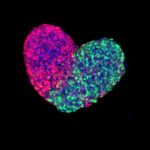Link to Pubmed [PMID] – 31770944
Link to DOI – 10.1103/PhysRevE.100.042111
Phys Rev E 2019 Oct; 100(4-1): 042111
To investigate novel aspects of pattern formation in spin systems, we use a mapping between reactive concentrations in a reaction-diffusion system and spin orientations in a dynamic multiple-spin Ising model. While pattern formation in Ising models always relies on infinite-range interactions, this mapping allows us to design a finite-range-interactions Ising model that can produce patterns observed in reaction-diffusion systems including Turing patterns with a tunable typical length scale. This model has asymmetric interactions and several spin types coexisting at a site. While we use the example of genetic regulation during embryogenesis to build our model, it can be used to study the behavior of other complex systems of interacting agents.
